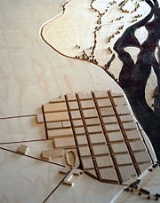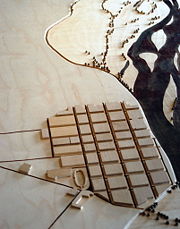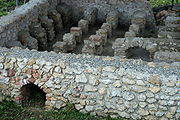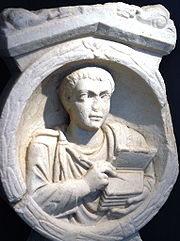
Flavia Solva
Encyclopedia
Flavia Solva was a municipium
in the ancient Roman province of Noricum
. It was situated on the western banks of the Mur river, close to the modern cities of Wagna
and Leibnitz
in the southern parts of the Austria
n province of Styria. It is the only Roman city in modern Styria.

 The Celto-Roman dwelling on the banks of the Mur river that should later become Flavia Solva was founded around year 15. while Noricum was still a Roman protectorate. This precursor consisted of a small cluster of wooden buildings, and did not follow a grand layout plan. It is believed that the Celtic element in its population came from the hill settlement on the nearby Frauenberg which had a tradition tracing back to neolithic ages. Very few remains from this phase have been found.
The Celto-Roman dwelling on the banks of the Mur river that should later become Flavia Solva was founded around year 15. while Noricum was still a Roman protectorate. This precursor consisted of a small cluster of wooden buildings, and did not follow a grand layout plan. It is believed that the Celtic element in its population came from the hill settlement on the nearby Frauenberg which had a tradition tracing back to neolithic ages. Very few remains from this phase have been found.
Shortly after the annexation of Noricum as a Roman province, the place was made a municipium around year 70 by emperor Vespasian
who added the name of his Flavian dynasty
to the local name Solva which might have referred to the Frauenberg settlement (which remained important as a worship site for Isis Noreia, a local adaptation of the Isis
cult), or to the nearby river Sulm. The construction activity that followed resulted in an almost entirely new city of stone buildings, with a layout that approximated the ideal of a Roman provincial municipium: rectangular insulae
(sized about 60 by 70 meters) within a grid of broad (ca. 6 m) gravel-paved streets. Some of the apartment houses in these blocks had hypocaust
heating, similar to what is known from comparable Roman cities; however, Flavia Solva had neither an aqueduct
nor canalization. The 80 x 35 m ellipsoid amphitheatre
(apparently the only one in Noricum) consisted of wooden benches on stone foundations.
The city was situated at the crossings of a Roman road connecting Poetovia (modern Ptuj
in Slovenia
) to Ovilava (modern Wels
) and the Danube
in Upper Austria
with a minor trade route connecting the administrative center at Virunum
in the Carinthian basin across the Koralpe
and through the Sulm valley to Pannonia
. However, the wealth of Flavia Solva seems to have been derived more from agriculture than from trade, and was relatively modest. In the Roman sources known to today's historians the city is mentioned only once, in Pliny the Elder
's Naturalis historia (Vol. 3, chapter 24, 146).
mountains in the North, the Koralpe
in the West, the river Drau in the South, and the river Lafnitz
in the East. In spite of its important local role, the city was never fortified.
 Flavia Solva and its surroundings had developed a modest degree of provincial luxury, with the villa rustica
Flavia Solva and its surroundings had developed a modest degree of provincial luxury, with the villa rustica
as the typical form of aristocratic countryside residence and agricultural cultivation, when its peaceful development was ended by its first destruction in 166. At this time the Marcomanni
breached the Danube Limes
between the fortifications of Vindobona
(modern Vienna
) and Carnuntum
, penetrated northwestern Pannonia
and eastern Noricum
using the Roman road system tracing the ancient Amber Road
along the eastern fringe of the Alps, and could be stopped by emperor Marcus Aurelius's hastily assembled militia only shortly before reaching Aquileia
.
Flavia Solva was rebuilt (though originally much smaller) under Marcus Aurelius's son and successor Commodus
, and flourished again a few decades later. By the early 3rd century, the city had a well-organized public fire brigade as evidenced by the Tabula Centonariorum membership list dating from 205.
Flavia Solva lost much of its importance during the late 4th century when the region suffered more incursions. The city was destroyed again in 405 (most probably during the Germanic invasion of Italy by Radagaisus
), but some isolated finds referring to emperor Marcian
suggest that a residual settlement must have remained at least until the 450s. At this time, most of the remaining population had moved back uphill to the Frauenberg where they established a new fortified settlement. The associated cemetery, which was identified only in the 1990s, is the largest from this latest Roman times known to exist in the eastern Alpine region.
The ruins of Flavia Solva were still a landmark during the Middle Ages although its origins were long forgotten, and they served the population as convenient quarries for construction material. The Renaissance
period, and later on Romanticism
, precipitated renewed interest in Roman history. During the 19th century, many gravestones and a considerable amount of stone artwork was incorporated in the nearby Schloss Seggau
where they can still be seen. However, it was not until 1845 that Richard Knabl
, a local parish priest and amateur historian, identified the site near the modern city of Leibnitz
as the remains of Flavia Solva.
, and a sewage trench that was dug across the site in the 1970s have caused much irretrievable damage. Over the decades, an area of 650 x 600 m (comprising about 40 insulae) has been excavated to some degree, although much of the finds are not visible today because the areas were reclaimed for agriculture or buried under modern buildings. A considerable piece of land which geoprospection has shown to harbor ruins has been placed under government protection. However, the full extent of the ancient city is still unknown.
A bone flute
with three finger holes, presumably a shepherd's instrument, was excavated in such a well-preserved state that it can be played today.
The Styrian exhibition of 2004 had its focus on Flavia Solva. The Joanneum at Wagna
maintains a permanent exhibition.
Municipium
Municipium , the prototype of English municipality, was the Latin term for a town or city. Etymologically the municipium was a social contract between municipes, the "duty holders," or citizens of the town. The duties, or munera, were a communal obligation assumed by the municipes in exchange for...
in the ancient Roman province of Noricum
Noricum
Noricum, in ancient geography, was a Celtic kingdom stretching over the area of today's Austria and a part of Slovenia. It became a province of the Roman Empire...
. It was situated on the western banks of the Mur river, close to the modern cities of Wagna
Wagna
Wagna is a municipality in the district of Leibnitz in Styria, Austria. The ancient Roman town of Flavia Solva lies near what is today Wagna.-References:...
and Leibnitz
Leibnitz
Leibnitz is a city in the Austrian state of Styria and at the 2001 census had a population of approximately 7.577 .It is located to the south of the city of Graz, between the Mur and Sulm rivers....
in the southern parts of the Austria
Austria
Austria , officially the Republic of Austria , is a landlocked country of roughly 8.4 million people in Central Europe. It is bordered by the Czech Republic and Germany to the north, Slovakia and Hungary to the east, Slovenia and Italy to the south, and Switzerland and Liechtenstein to the...
n province of Styria. It is the only Roman city in modern Styria.
Foundation and layout


Shortly after the annexation of Noricum as a Roman province, the place was made a municipium around year 70 by emperor Vespasian
Vespasian
Vespasian , was Roman Emperor from 69 AD to 79 AD. Vespasian was the founder of the Flavian dynasty, which ruled the Empire for a quarter century. Vespasian was descended from a family of equestrians, who rose into the senatorial rank under the Emperors of the Julio-Claudian dynasty...
who added the name of his Flavian dynasty
Flavian dynasty
The Flavian dynasty was a Roman Imperial Dynasty, which ruled the Roman Empire between 69 and 96 AD, encompassing the reigns of Vespasian , and his two sons Titus and Domitian . The Flavians rose to power during the civil war of 69, known as the Year of the Four Emperors...
to the local name Solva which might have referred to the Frauenberg settlement (which remained important as a worship site for Isis Noreia, a local adaptation of the Isis
Isis
Isis or in original more likely Aset is a goddess in Ancient Egyptian religious beliefs, whose worship spread throughout the Greco-Roman world. She was worshipped as the ideal mother and wife as well as the matron of nature and magic...
cult), or to the nearby river Sulm. The construction activity that followed resulted in an almost entirely new city of stone buildings, with a layout that approximated the ideal of a Roman provincial municipium: rectangular insulae
Insulae
In Roman architecture, an insula was a kind of apartment building that housed most of the urban citizen population of ancient Rome, including ordinary people of lower- or middle-class status and all but the wealthiest from the upper-middle class...
(sized about 60 by 70 meters) within a grid of broad (ca. 6 m) gravel-paved streets. Some of the apartment houses in these blocks had hypocaust
Hypocaust
A hypocaust was an ancient Roman system of underfloor heating, used to heat houses with hot air. The word derives from the Ancient Greek hypo meaning "under" and caust-, meaning "burnt"...
heating, similar to what is known from comparable Roman cities; however, Flavia Solva had neither an aqueduct
Aqueduct
An aqueduct is a water supply or navigable channel constructed to convey water. In modern engineering, the term is used for any system of pipes, ditches, canals, tunnels, and other structures used for this purpose....
nor canalization. The 80 x 35 m ellipsoid amphitheatre
Amphitheatre
An amphitheatre is an open-air venue used for entertainment and performances.There are two similar, but distinct, types of structure for which the word "amphitheatre" is used: Ancient Roman amphitheatres were large central performance spaces surrounded by ascending seating, and were commonly used...
(apparently the only one in Noricum) consisted of wooden benches on stone foundations.
The city was situated at the crossings of a Roman road connecting Poetovia (modern Ptuj
Ptuj
Ptuj is a city and one of 11 urban municipalities in Slovenia. Traditionally the area was part of the Lower Styria region. The municipality is now included in the Podravje statistical region...
in Slovenia
Slovenia
Slovenia , officially the Republic of Slovenia , is a country in Central and Southeastern Europe touching the Alps and bordering the Mediterranean. Slovenia borders Italy to the west, Croatia to the south and east, Hungary to the northeast, and Austria to the north, and also has a small portion of...
) to Ovilava (modern Wels
Wels
Wels is the second largest city of the state of Upper Austria, located in the north of Austria, on the Traun River near Linz. It is not part of its surrounding Wels County , but a so-called Statutarstadt . However, Wels is the county seat of Wels-Land.- Geography :Wels is located in the...
) and the Danube
Danube
The Danube is a river in the Central Europe and the Europe's second longest river after the Volga. It is classified as an international waterway....
in Upper Austria
Upper Austria
Upper Austria is one of the nine states or Bundesländer of Austria. Its capital is Linz. Upper Austria borders on Germany and the Czech Republic, as well as on the other Austrian states of Lower Austria, Styria, and Salzburg...
with a minor trade route connecting the administrative center at Virunum
Virunum
Claudium Virunum was a Roman city in the province of Noricum, on today's Zollfeld in the Austrian State of Carinthia. Virunum may also have been the name of the older Celtic-Roman settlement on the hilltop of Magdalensberg nearby....
in the Carinthian basin across the Koralpe
Koralpe
The Koralpe, also referred to as Koralm, is a mountain range in southern Austria which separates eastern Carinthia from southern Styria. Running from north to south, it drains to the river Lavant in the west, and to the river Sulm in the east...
and through the Sulm valley to Pannonia
Pannonia
Pannonia was an ancient province of the Roman Empire bounded north and east by the Danube, coterminous westward with Noricum and upper Italy, and southward with Dalmatia and upper Moesia....
. However, the wealth of Flavia Solva seems to have been derived more from agriculture than from trade, and was relatively modest. In the Roman sources known to today's historians the city is mentioned only once, in Pliny the Elder
Pliny the Elder
Gaius Plinius Secundus , better known as Pliny the Elder, was a Roman author, naturalist, and natural philosopher, as well as naval and army commander of the early Roman Empire, and personal friend of the emperor Vespasian...
's Naturalis historia (Vol. 3, chapter 24, 146).
Role in Roman administration
The administrative district of Flavia Solva covered much of what today is central Styria. Its approximate borders probably were the EisenerzEisenerz
Eisenerz is a market place and old mining town in Styria, Austria, . N.W. of Graz by rail. Pop. 6,400. It is situated in the deep Erzbach Valley, dominated on the east by the Pfaffenstein , on the west by the Kaiserschild , and on the south by the Erzberg...
mountains in the North, the Koralpe
Koralpe
The Koralpe, also referred to as Koralm, is a mountain range in southern Austria which separates eastern Carinthia from southern Styria. Running from north to south, it drains to the river Lavant in the west, and to the river Sulm in the east...
in the West, the river Drau in the South, and the river Lafnitz
Lafnitz
----Lafnitz is a municipality in the district of Hartberg in Styria, Austria....
in the East. In spite of its important local role, the city was never fortified.
Destructions, decline, and rediscovery

Villa rustica
Villa rustica was the term used by the ancient Romans to denote a villa set in the open countryside, often as the hub of a large agricultural estate . The adjective rusticum was used to distinguish it from an urban or resort villa...
as the typical form of aristocratic countryside residence and agricultural cultivation, when its peaceful development was ended by its first destruction in 166. At this time the Marcomanni
Marcomanni
The Marcomanni were a Germanic tribe, probably related to the Buri, Suebi or Suevi.-Origin:Scholars believe their name derives possibly from Proto-Germanic forms of "march" and "men"....
breached the Danube Limes
Limes
A limes was a border defense or delimiting system of Ancient Rome. It marked the boundaries of the Roman Empire.The Latin noun limes had a number of different meanings: a path or balk delimiting fields, a boundary line or marker, any road or path, any channel, such as a stream channel, or any...
between the fortifications of Vindobona
Vindobona
Vindobona was originally a Celtic settlement, and later a Roman military camp on the site of the modern city of Vienna in Austria. Around 15 BC, the kingdom of Noricum was included in the Roman Empire...
(modern Vienna
Vienna
Vienna is the capital and largest city of the Republic of Austria and one of the nine states of Austria. Vienna is Austria's primary city, with a population of about 1.723 million , and is by far the largest city in Austria, as well as its cultural, economic, and political centre...
) and Carnuntum
Carnuntum
Carnuntum was a Roman army camp on the Danube in the Noricum province and after the 1st century the capital of the Upper Pannonia province...
, penetrated northwestern Pannonia
Pannonia
Pannonia was an ancient province of the Roman Empire bounded north and east by the Danube, coterminous westward with Noricum and upper Italy, and southward with Dalmatia and upper Moesia....
and eastern Noricum
Noricum
Noricum, in ancient geography, was a Celtic kingdom stretching over the area of today's Austria and a part of Slovenia. It became a province of the Roman Empire...
using the Roman road system tracing the ancient Amber Road
Amber Road
The Amber Road was an ancient trade route for the transfer of amber. As one of the waterways and ancient highways, for centuries the road led from Europe to Asia and back, and from northern Africa to the Baltic Sea....
along the eastern fringe of the Alps, and could be stopped by emperor Marcus Aurelius's hastily assembled militia only shortly before reaching Aquileia
Aquileia
Aquileia is an ancient Roman city in what is now Italy, at the head of the Adriatic at the edge of the lagoons, about 10 km from the sea, on the river Natiso , the course of which has changed somewhat since Roman times...
.
Flavia Solva was rebuilt (though originally much smaller) under Marcus Aurelius's son and successor Commodus
Commodus
Commodus , was Roman Emperor from 180 to 192. He also ruled as co-emperor with his father Marcus Aurelius from 177 until his father's death in 180. His name changed throughout his reign; see changes of name for earlier and later forms. His accession as emperor was the first time a son had succeeded...
, and flourished again a few decades later. By the early 3rd century, the city had a well-organized public fire brigade as evidenced by the Tabula Centonariorum membership list dating from 205.
Flavia Solva lost much of its importance during the late 4th century when the region suffered more incursions. The city was destroyed again in 405 (most probably during the Germanic invasion of Italy by Radagaisus
Radagaisus
Radagaisus was a Gothic king who led an invasion of Roman Italy in late 405 and the first half of 406. A commited Pagan, Radagaisus evidentily planned to sacrifice the Roman Senators to the gods and burn Rome to the ground. Radagaisus was executed after being defeated by the half-Vandal general...
), but some isolated finds referring to emperor Marcian
Marcian
Marcian was Byzantine Emperor from 450 to 457. Marcian's rule marked a recovery of the Eastern Empire, which the Emperor protected from external menaces and reformed economically and financially...
suggest that a residual settlement must have remained at least until the 450s. At this time, most of the remaining population had moved back uphill to the Frauenberg where they established a new fortified settlement. The associated cemetery, which was identified only in the 1990s, is the largest from this latest Roman times known to exist in the eastern Alpine region.
The ruins of Flavia Solva were still a landmark during the Middle Ages although its origins were long forgotten, and they served the population as convenient quarries for construction material. The Renaissance
Renaissance
The Renaissance was a cultural movement that spanned roughly the 14th to the 17th century, beginning in Italy in the Late Middle Ages and later spreading to the rest of Europe. The term is also used more loosely to refer to the historical era, but since the changes of the Renaissance were not...
period, and later on Romanticism
Romanticism
Romanticism was an artistic, literary and intellectual movement that originated in the second half of the 18th century in Europe, and gained strength in reaction to the Industrial Revolution...
, precipitated renewed interest in Roman history. During the 19th century, many gravestones and a considerable amount of stone artwork was incorporated in the nearby Schloss Seggau
Schloss Seggau
Schloss Seggau is a castle situated in the locality Seggauberg in the southern Styria Province of Austria. It is located on a wooded hill overlooking the town of Leibnitz.- History :...
where they can still be seen. However, it was not until 1845 that Richard Knabl
Richard Knabl
Richard Knabl was an Austrian parish priest and epigraphist who, though he lacked formal academic training as a historian, became a prominent contributor to our current knowledge of the Roman period in Noricum and eastern Pannonia, especially on the territory of modern Styria.-Youth and parish...
, a local parish priest and amateur historian, identified the site near the modern city of Leibnitz
Leibnitz
Leibnitz is a city in the Austrian state of Styria and at the 2001 census had a population of approximately 7.577 .It is located to the south of the city of Graz, between the Mur and Sulm rivers....
as the remains of Flavia Solva.
Modern excavations
Flavia Solva has been a major focus for Austrian archaeology since the early 20th century; unfortunately (but typically) because construction activity constantly precipitated emergency digs. Road construction, the expansion of nearby WagnaWagna
Wagna is a municipality in the district of Leibnitz in Styria, Austria. The ancient Roman town of Flavia Solva lies near what is today Wagna.-References:...
, and a sewage trench that was dug across the site in the 1970s have caused much irretrievable damage. Over the decades, an area of 650 x 600 m (comprising about 40 insulae) has been excavated to some degree, although much of the finds are not visible today because the areas were reclaimed for agriculture or buried under modern buildings. A considerable piece of land which geoprospection has shown to harbor ruins has been placed under government protection. However, the full extent of the ancient city is still unknown.
A bone flute
Flute
The flute is a musical instrument of the woodwind family. Unlike woodwind instruments with reeds, a flute is an aerophone or reedless wind instrument that produces its sound from the flow of air across an opening...
with three finger holes, presumably a shepherd's instrument, was excavated in such a well-preserved state that it can be played today.
The Styrian exhibition of 2004 had its focus on Flavia Solva. The Joanneum at Wagna
Wagna
Wagna is a municipality in the district of Leibnitz in Styria, Austria. The ancient Roman town of Flavia Solva lies near what is today Wagna.-References:...
maintains a permanent exhibition.

